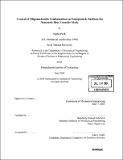| dc.contributor.advisor | Kimberly Hamad-Schifferli. | en_US |
| dc.contributor.author | Park, Sunho, 1976- | en_US |
| dc.contributor.other | Massachusetts Institute of Technology. Dept. of Mechanical Engineering. | en_US |
| dc.date.accessioned | 2005-09-06T21:50:36Z | |
| dc.date.available | 2005-09-06T21:50:36Z | |
| dc.date.copyright | 2004 | en_US |
| dc.date.issued | 2004 | en_US |
| dc.identifier.uri | http://hdl.handle.net/1721.1/27120 | |
| dc.description | Thesis (S.M.)--Massachusetts Institute of Technology, Dept. of Mechanical Engineering, 2004. | en_US |
| dc.description | Includes bibliographical references (leaves 77-82). | en_US |
| dc.description.abstract | Metal nanoparticles can be used as antennae covalently linked to biomolecules. External alternating magnetic field can turn on and off the biological activity of the molecules due to induction heating from the particles that changes the temperature around the molecules. Here an experimental scheme towards direct temperature probing is proposed to predict the behavior of the antenna. Oligonucleotides modified with photosensitive molecules are conjugated with gold nanoparticles and report the temperature at their positions within some nanometers' distance from the particles. However, oligos have a known tendency to stick to gold surfaces. To locate the probes at desired position, 6-mercapto-1-hexanol (MCH) is used to reduce oligonucleotides' adsorption to the surface of gold. The experimental result shows that oligos on particle's surface can be stretched radially without any reduction of coverage ratio. Optimal MCH concentration and reaction time highly depend on the concentration of MCH and the conjugates as well as reaction time and the size of the molecules. | en_US |
| dc.description.statementofresponsibility | by Sunho Park. | en_US |
| dc.format.extent | 82 leaves | en_US |
| dc.format.extent | 3723339 bytes | |
| dc.format.extent | 3732093 bytes | |
| dc.format.mimetype | application/pdf | |
| dc.format.mimetype | application/pdf | |
| dc.language.iso | en_US | |
| dc.publisher | Massachusetts Institute of Technology | en_US |
| dc.rights | M.I.T. theses are protected by copyright. They may be viewed from this source for any purpose, but reproduction or distribution in any format is prohibited without written permission. See provided URL for inquiries about permission. | en_US |
| dc.rights.uri | http://dspace.mit.edu/handle/1721.1/7582 | |
| dc.subject | Mechanical Engineering. | en_US |
| dc.title | Control of oligonucleotide conformation on nanoparticle surfaces for nanoscale heat transfer study | en_US |
| dc.type | Thesis | en_US |
| dc.description.degree | S.M. | en_US |
| dc.contributor.department | Massachusetts Institute of Technology. Department of Mechanical Engineering | |
| dc.identifier.oclc | 56842672 | en_US |
